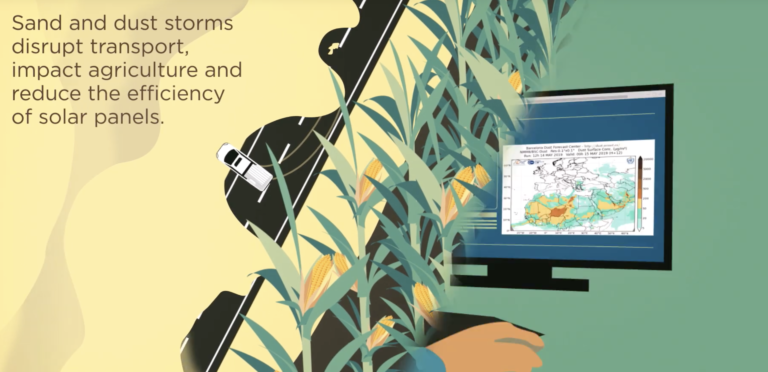An international coalition has been formed to deal with the devastating effects of sand and dust storms on health and the environment. The coalition includes the WMO and other UN bodies such as the UN Convention to Combat Desertification (UNCCD), the World Health Organization (WHO) and the World Bank.
Its formation was announced at the recent UNCCD conference in New Delhi. In his opening remarks UNCCD executive secretary Ibrahim Thiaw told the conference that sand and dust storms were “a phenomenon severely and increasingly affecting 151 countries in Africa, Asia, North America and Australia.” He added: “It’s a global crisis.”
According to the WMO, sand and dust storms are common in arid and semi-arid regions where high winds caused by thunderstorms or weather systems associated with cyclones lift particles from barren, dry soils up into the atmosphere.
Every year about two billion tons of dust enters the atmosphere. The main sources of this atmospheric sand and dust are the arid regions of North Africa, the Arabian Peninsula, Central Asia and China. A small but significant amount is also generated in Australia, America and South Africa.
The dust particles can be transported across vast distances and deposited in faraway regions. Sand and dust deposited in the oceans is a rich source of nutrients for marine life. On land, however, it can have devastating effects. In May 2018, for example, high-velocity dust storms killed 125 people and injured 200 more in the northern Indian states of Uttar Pradesh and Rajasthan.
While most dust storms are not fatal, they can still have a severe effect on the weather, human health and the environment. As well as irritating skin and eyes, dust particles can cause respiratory and heart problems and also contribute to the spread of airborne diseases such as meningitis.
Dust storms can also disrupt transport, impact crop growth and reduce the effectiveness of solar panels. While much of the dust entering the atmosphere is due to natural processes, a large proportion of it is caused by poor land and water management leading to rising desertification, which in turn causes more droughts.
In the past year alone 25 countries announced emergency measures in response to widespread drought. “It is estimated that desertification alone is generating a loss of between 10% and 17% of global GDP,” Thiaw told the conference, which also hosted an appearance by the Indian Prime Minister Narendra Modi.
According to the WMO the new coalition will be tasked with preparing “a global response to sand and dust storms, including a strategy and an action plan, which could result in the development of a UN system-wide approach.”
Over the past decade the WMO has implemented various measures to combat dust storms, including the Sand and Dust Storm Warning Advisory and Assessment System (SDS-WAS).
Operational since 2007, the SDS-WAS is an international partnership for sharing research. It also provides forecasting through two operational centers: the Barcelona Dust Forecast Center, which provides forecasts for North Africa, the Middle East and Europe and an Asian forecasting center run by the Chinese Meteorological Administration.



